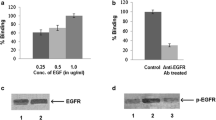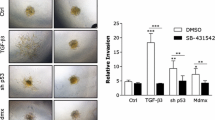Abstract
Evidence suggests that there is an association between the abnormal expression of members of the c-erbB receptor tyrosine kinase family and poor prognosis in head and neck squamous cell carcinomas (HNSCC). Until now, the relative contributions of different c-erbB ligands to HNSCC progression have not been clearly defined. In this paper we examined the effects of ligands with different c-erbB receptor specificities in terms of their stimulation of HNSCC proliferation, expression of matrix metalloproteinases (MMPs) and invasion. Heregulin-beta1 (HRG-β1; selective c-erbB3/B4 ligand) was found to stimulate proliferation in the majority of cell lines, whereas epidermal growth factor (EGF; EGFR ligand) and betacellulin (BTC; EGFR/B4 ligand) induced variable responses. All three ligands up-regulated multiple MMPs including collagenases, stromelysins, matrilysin and gelatinase B (MMP-9) but had minimal or no effects on gelatinase A (MMP-2), MT1-MMP and tissue inhibitors of MMPs (TIMPs). MMP-9 mRNA was induced to a higher level than other MMPs, although with slower kinetics. HRG-β1 was less active than EGF and BTC at the optimal concentration (relative potency of EGF:BTC:HRG = 3:4:1). In vitro invasion through Matrigel was also increased by all three ligands in proportion to their MMP up-regulation. A specific anti-EGFR monoclonal antibody (mAb ICR62) inhibited MMP up-regulation, migration and invasion induced by all three ligands, whereas an anti-c-erbB-2 mAb ICR12 inhibited mitogenic and motogenic responses following ligand stimulation but had no effect on MMP expression. These results suggest that c-erbB ligands may differentially potentiate the invasive phenotype of HNSCC via co-operative induction of cell proliferation, migration and proteolysis. The EGFR signalling pathway appears to be the dominant component controlling the proteolytic and invasive phenotype in HNSCC, whereas the c-erbB-2 signalling pathway is responsible, in part, for the mitogenic and motogenic effects of ligands.
Similar content being viewed by others
References
Eccles SA, Modjtahedi H, Box G et al. Significance of the c-erbB family of receptor tyrosine kinases in metastatic cancer and their potential as targets for immunotherapy. Inv Metastasis 1994; 14: 337–48.
Klapper LN, Kirschbaum MH, Sela M et al. Biochemical and clinical implications of the ErbB/HER signalling network of growth factor receptors. Adv Cancer Res 2000; 77: 25–79.
Riese II DJ, Stern DF. Specificity within the EGF family/ErbB receptor family signaling network. BioEssays 1998; 20: 41–8.
Wen D, Suggs SV, Karunagaran D et al. Structural and functional aspects of the multiplicity of Neu differentiation factors. Mol Cell Biol 1994; 14: 1909–19.
Weiss FU, Wallasch C, Campiglio M et al. Distinct characteristics of heregulin signals mediated by HER3 or HER4. J Cell Physiol 1997; 173: 187–95.
Klapper LN, Glathe S, Vaisman N et al. The ErbB-2/HER2 oncoprotein of human carcinomas may function solely as a shared coreceptor for multiple stroma-derived growth factors. PNAS 1999; 96: 4995–5000.
Spencer KSR, Graus-Porta D, Leng J et al. ErbB2 is necessary for induction of carcinoma cell invasion by ErbB family receptor tyrosine kinases. J Cell Biol 2000; 148: 385–97.
Dassonville O, Formento JL, Francoual M et al. Expression of epidermal growth factor receptor and survival in upper aerodigestive tract cancer. J Clin Oncol 1993; 11: 1873–8.
Grandis JR, Melhem MF, Gooding WE et al. Levels of TGF-alpha and EGFR protein in head and neck squamous cell carcinoma and patient survival. J Natl Cancer Inst 1998; 90: 824–32.
Kearsley JH, Leonard JH, Walsh MD et al. A comparison of epidermal growth factor receptor (EGFR) and c-erbB-2 oncogene expression in head and neck squamous cell carcinomas. Pathology 1991; 23: 189–94.
Riviere A, Becker J, Loning T. Comparative investigation of cerbB2/ neu expression in head and neck tumors and mammary cancer. Cancer 1991; 67: 2142–9.
Craven JM, Pavelic ZP, Stambrook PJ et al. Expression of c-erbB2 gene in human head and neck carcinoma. Anticancer Res 1992; 12: 2273–6.
Field JK, Spandidos DA, Yiagnisis M et al. c-erbB2 expression in squamous cell carcinoma of the head and neck. Anticancer Res 1992; 12: 613–20.
Hou L, Shi D, Tu SM et al. Oral cancer progression and c-erbB-2/neu proto-oncogene expression. Cancer Lett 1992; 65: 215–20.
Issing WJ, Heppt WJ, Kastenbauer ER. erbB-3, a third member of the erbB/epidermal growth factor receptor gene family: Its expression in head and neck cancer cell lines. Eur Arch Otorhinolaryngol 1993; 250: 392–5.
Shintani S, Funayama T, Yoshihama Y et al. Prognostic significance of ERBB3 overexpression in oral squamous cell carcinoma. Cancer Lett 1995; 95: 79–83.
Rodrigo JP, Ramos S, Lazo PS et al. Amplification of ERBB oncogenes in squamous cell carcinomas of the head and neck. Eur J Cancer Part A 1996; 32: 2004–10.
Ibrahim SO, Vasstrand EN, Liavaag PG et al. Expression of c-erbB proto-oncogene family members in squamous cell carcinoma of the head and neck. Anticancer Res 1997; 17: 4539–46.
Funayama T, Nakanishi T, Takahashi K et al. Overexpression of c-erbB-3 in various stages of human squamous cell carcinomas. Oncology 1998; 55: 161–7.
Srinivasan R, Poulsom R, Hurst HC et al. Expression of the c-erbB-4/HER4 protein and mRNA in normal human fetal and adult tissues and in a survey of nine solid tumour types. J Pathol 1998; 185: 236–45.
Stetler-Stevenson WG, Aznavoorian S, Liotta A. Tumor cell interactions with the extracellular matrix during invasion and metastasis. Annu Rev Cell Biol 1993; 9: 541–73.
Jones JL, Walker RA. Control of matrix metalloproteinase activity in cancer. J Pathol 1997; 183: 377–9.
O-charoenrat P, Modjtahedi H, Rhys-Evans P et al. Epidermal growth factor-like ligands differentially upregulate matrix metalloproteinase-9 in head and neck squamous carcinoma cells. Cancer Res 2000; 60: 1121–8.
O-charoenrat P, Rhys-Evans P, Modjtahedi H et al. Over-expression of epidermal growth factor receptor in human head and neck squamous carcinoma cell lines correlates with matrix metalloproteinase-9 expression and in vitro invasion. Int J Cancer 2000; in press.
Modjtahedi H, Komurasaki T, Toyoda H et al. Anti-EGFR monoclonal antibodies which act as EGF, TGFa, HB-EGF and BTC antagonists block the binding of epiregulin to EGFR-expressing tumours. Int J Cancer 1998; 75: 310-6.
Styles JM, Harrison S, Gusterson BA et al. Rat monoclonal antibodies to the external domain of the product of the C-erbB-2 proto-oncogene. Int J Cancer 1990; 45: 320–4.
Thomas GT, Lewis MP, Speight PM. Matrix metalloproteinases and oral cancer. Oral Oncol 1999; 35: 227–33.
Carraway KLI, Sliwkowski MX, Akita R et al. The erbB3 gene product is a receptor for heregulin. J Biol Chem 1994; 269: 14303–6.
Lewis GD, Lofgren JA, McMurrey AE et al. Growth regulation of human breast and ovarian tumor cells by heregulin: Evidence for the requirement of ErbB2 as a critical component in mediating heregulin responsiveness. Cancer Res 1996; 56: 1457–65.
Lyons JG, Birkedal-Hansen B, Pierson MC et al. Interleukin-1β and transforming growth factor-α/epidermal growth factor induce expression of M r 95,000 type IV collagenase/gelatinase and interstitial fibroblast-type collagenase by rat mucosal keratinocytes. J Biol Chem 1993; 268: 19143–51.
Kerr LD, Holt JT, Matrisian LM. Growth factors regulate transin gene expression by c-fos-dependent and c-fos-independent pathways. Science 1988; 242: 1424–7.
Rosenthal EL, Johnson TM, Allen ED et al. Role of the plasminogen activator and matrix metalloproteinase systems in epidermal growth factor-and scatter factor-stimulated invasion of carcinoma cells. Cancer Res 1998; 58: 5221–30.
Gaire M, Magbanua Z, McDonnell S et al. Structure and expression of the human gene for the matrix metalloproteinase matrilysin. J Biol Chem 1994; 269: 2032–40.
Windsor LJ, Grenett H, Birkedal-Hansen B et al. Cell-type specific regulation of SL-1 and SL-2 genes. Induction of the SL-2 gene but not the SL-1 gene by human keratinocytes in response to cytokines and phorbol esters. J Biol Chem 1993; 268: 17341–7.
Basset P, Bellocq JP, Wolf C et al. A novel metalloproteinase gene family in humans consists of at least four members. Biochem J 1990; 348: 699–704.
Borden P, Heller RA. Transcriptional control of matrix metalloproteinases and the tissue inhibitors of matrix metalloproteinases. Crit Rev Eukaryot Gene Expr 1997; 7: 159–78.
Sato H, Seiki M. Regulatory mechanism of 92 kDa type IV collagenase gene expression which is associated with invasiveness of tumor cells. Oncogene 1993; 8: 395–405.
Ye D, Mendelsohn J, Fan Z. Augmentation of a humanized anti-HER2 mAb 4D5 induced growth inhibition by a human-mouse chimeric anti-EGF receptor mAb C225. Oncogene 1999; 18: 731–8.
Author information
Authors and Affiliations
Rights and permissions
About this article
Cite this article
O-charoenrat, P., Rhys-Evans, P., Court, W.J. et al. Differential modulation of proliferation, matrix metalloproteinase expression and invasion of human head and neck squamous carcinoma cells by c-erbB ligands. Clin Exp Metastasis 17, 631–639 (1999). https://doi.org/10.1023/A:1006751016860
Issue Date:
DOI: https://doi.org/10.1023/A:1006751016860




